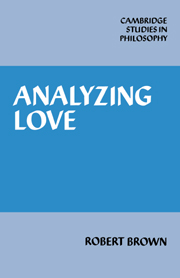4 - Emotions and attitudes: Loving a person
Published online by Cambridge University Press: 29 March 2010
Summary
scruton's distinction between emotions and attitudes
It is a striking feature of our terms for the emotions that many of the same terms are also used for character traits, for the virtues and vices, for the feelings, and for attitudes. ‘Courage’, ‘avarice’, ‘fear’, ‘jealousy’, ‘envy’, ‘pride’, ‘humility’, and ‘love’ are all obvious examples. It may seem obvious why such terms should be used to refer not only to our emotions and feelings but also to character traits – to the dispositions to display these emotions and feelings. The reasons why we appraise these dispositions as virtues and vices may seem to be clear enough. But what is the connection of the names of emotions with the names of attitudes?
One answer has been offered by Roger Scruton. His suggestion is that both attitudes and emotions ‘are expressed in directed behaviour; that is, behaviour of a consistent kind directed towards some object or class of objects’. Attitudes differ from emotions, however, in being ‘founded on belief, and a man can give up any attitude to the extent that he can give up the beliefs on which it is founded’. (1971, pp. 26–7) Emotions, on the other hand, are states in which ‘desires and wishes tend to exist in the context of relatively few beliefs and of perhaps no definite intentions’, (p. 30) To this distinction Scruton adds another. It is an elaboration of Aristotle's distinction in the Rhetoric between emotions that have universal objects and those that have particular objects.
- Type
- Chapter
- Information
- Analyzing Love , pp. 94 - 128Publisher: Cambridge University PressPrint publication year: 1987

